They were performed by only twenty-three people - all men. Six of them died fighting Muslims or held captive by the Prophet's followers. Death awaited the last one in terrible torments. What made them so exposed to such great dangers?
The mortality rate among the great masters of the Templar order was incomparably higher than that of the masters of other knightly orders, not to mention the rulers of the nations founded by the Crusaders in the Middle East. It was a bit in this case. But if we look at the circumstances in which the great Templar masters lost their lives, we can clearly see the greatness and smallness of this congregation through the lens.
Don't be greedy! [Bernard of Tremelay, 1153]
The Knights Templar amassed enormous wealth. They came not only from the grants of people who wanted to support monks-knights, but also from the spoils of war. They often stood in the front ranks of the Crusader troops. While it was a risk, it also gave you the prospect of catching up in front of others.
The most extreme example of a quick loot policy was the siege of Ascalon in 1153. When the Crusaders finally managed to breach the wall, the Templars led by Bernard of Temelay were the first. The grand master allowed no one other than the members of his congregation. As we read in the book by Paul Hill, which has just been published, “Templars at war. 1120-1312 ":
Forty of them stormed the city, but its inhabitants quickly realized that the attackers were cut off from the rest of the Christian forces, and cut them down. The defenders triumphed, blocked the breach with wood and whatever they could, then hung the dead bodies on the wall, mocking the Franks .
Bernard of Tremelay also died that day.
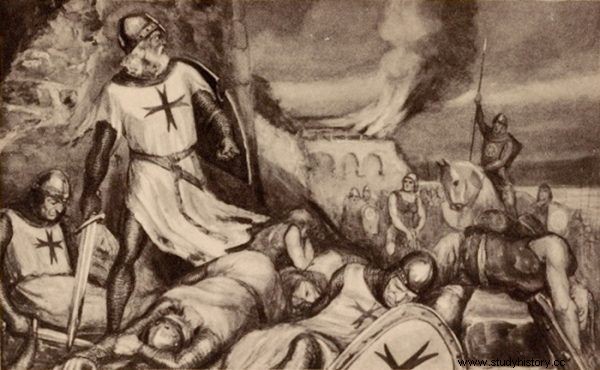
Bernard of Temelay's exaggerated lust for loot cost the lives of dozens of Templars. The Grand Master himself was also among them.
Pride more precious than freedom [Odon of Saint-Amand, 1179]
One of Bernard's successors, Odon of Saint-Amand, was a proud man. He did not hesitate to throw the gauntlet even on the king of Jerusalem, Amalryk I. It was about the case of a certain Templar, Walter of Mesnil, who killed the envoys of the famous Sinan (the Elder of the Mountains), the leader of the Assassin sect. Amalryk demanded to hand over the killer. Odon refused, considering that only the Pope could judge the Templars. In the end, the king had to order the kidnapping of Walter. The whole story shows both Odon's pride and the importance of knightly orders in the crusader countries.
Self-esteem - understood literally - was to cost the great master his life. On June 10, 1179, the crusaders were defeated against Saladin's army, and Odon was taken prisoner. The victorious sultan wanted to exchange him for his nephew, in the hands of the Knights Templar. The grand master refused, explaining that the members of his congregation either won or died, and that he could only give his belt and knife as a ransom. As a result, remained in a prison in Damascus, where he died a year later .
Up to three times a game [Gerard of Ridefort, 1189]
This most famous (not counting Jacob of Molay burned at the stake) Grand Master of the Knights Templar came from Flanders. Like many knights of that time, he sought his fortune in the Middle East. Count Raymond III of Tripoli promised him the hand of the first suitably wealthy heiress to appear on the local matrimonial market.
However, when this appeared, a certain Plivano, an Italian from Pisa, allegedly put the girl on the scales. He placed the gold on the other shawl and handed it to Raymond. And even if the weighing did not take place, the fact remains that the Count of Tripoli has acted disloyal to Gerard and made him a deadly enemy.
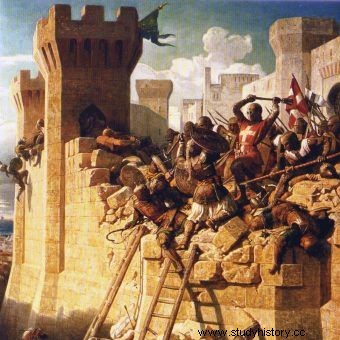
None of the top Crusaders was as vulnerable to death as the Grand Templar Master.
The disappointed knight joined the Knights Templar and later became a Grand Master. His political line can be summarized as "always in opposition to Raymond III." Which was disastrous for the Kingdom of Jerusalem.
As for Gerard himself, he did not always show courage. In 1187, in the Cresson Valley near Nazareth, he encountered a large detachment of Muslims. The Marshal of the Grand Master, Jakub from Mailly, advised him not to start. "You love your blonde head so much that you don't want to lose it," thought Gerard. "I will die in battle, as befits a brave husband. It is you, my lord, that will run away like a traitor. " Jacob replied.
And it happened as he said. The Marshal was killed and the Grand Master was among the few escapees. Soon after, he took part in the Battle of Hittin, in which Saladin defeated Christian troops. All the captive Templars were executed. With one exception - Gerard was spared his life.
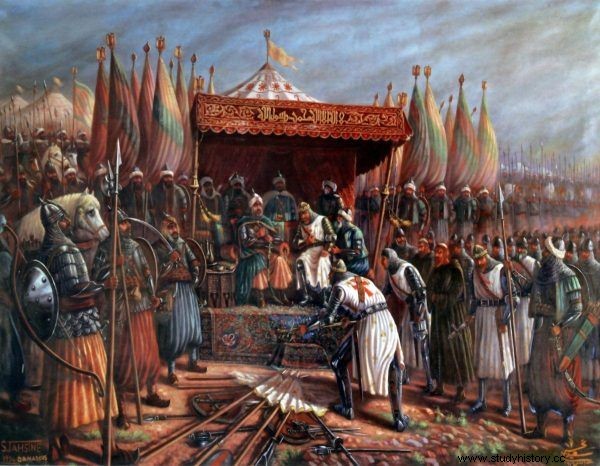
After the defeat at Hittin, Gerard of Ridefort was the only Templar to be spared his life. Two years later, however, she died in the fight against Saladin's troops.
Later, on the orders of Saladin, the Grand Master of the Templars, together with another significant prisoner, the King of Jerusalem, Gwidon of Lusignan, persuaded the inhabitants of Ascalon to surrender, but they replied with insults. Gerard did better with Gaza in the hands of the Templars. The word of the great master was a command for them. They gave the fortress to the Muslims and in return Gerard was released.
However, he paid for his ambiguous attitude with his own blood. In October 1189 he fought bravely at Akka with the army of the Sultan. According to one version he died in battle, according to the other he was taken prisoner again, but this time Saladin did not show him mercy and gave him the death sentence.
Hand in hand with the Muslims [Armand of Périgord, 1244?]
Christians, specifically the German Emperor Frederick II, managed to regain Jerusalem, lost in 1187, in 1229 - not through an armed confrontation, but through diplomatic negotiations. The real challenge, however, was maintaining it.
Crusader forces in the Middle East were small. The Grand Master of the Templars Armand of Périgord wanted to take advantage of the disagreements between the Muslim rulers of the Ayyubid dynasty (named after Ajub, Saladin's father), which was really the only guarantee for the survival of the Kingdom of Jerusalem.
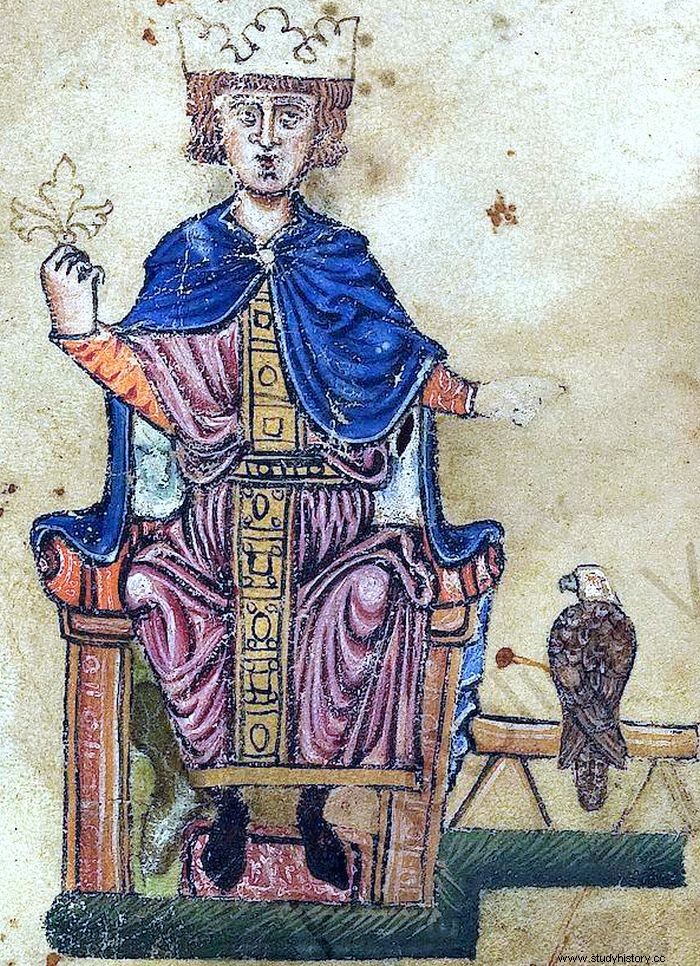
Emperor Frederick II regained Jerusalem for the Christians.
In this context, it is not surprising that the alliance system of October 1244, when two armies clashed in a two-day battle near the village of Harbijja, called La Forbie by the Franks. Christians fought in the first ranks, supported by the Muslims of Himsu and Damascus. As the famous historian Steven Runciman wrote, "there was an exemplary camaraderie" between them. The second ranks included the Egyptian army and the Chorezmy Turks allied with them.
The Battle of La Forbie ended in a terrible defeat for the Christians. Many Knights Templar died, including the supposedly Grand Master Armand of Périgord himself. Supposedly, because according to the chronicler Matthew of Paris, in 1246 negotiations were underway on his redemption from Muslim captivity.
It seems that this is the result of contradictory information about the fate of the great master, not the first and not the last such case in history. In any event, by 1247 it was already certain that he was dead and his successor was elected .
Death of the one-eyed master [William of Sonnac, 1250]
In the middle of the thirteenth century, the only European ruler who really had a hard time regaining Jerusalem was King Louis IX of France. Unfortunately, he took his younger brother, Count Robert of Artois, on the Crusade. This one did not know the local realities, and in addition he was stubborn and passionate - an explosive mixture.
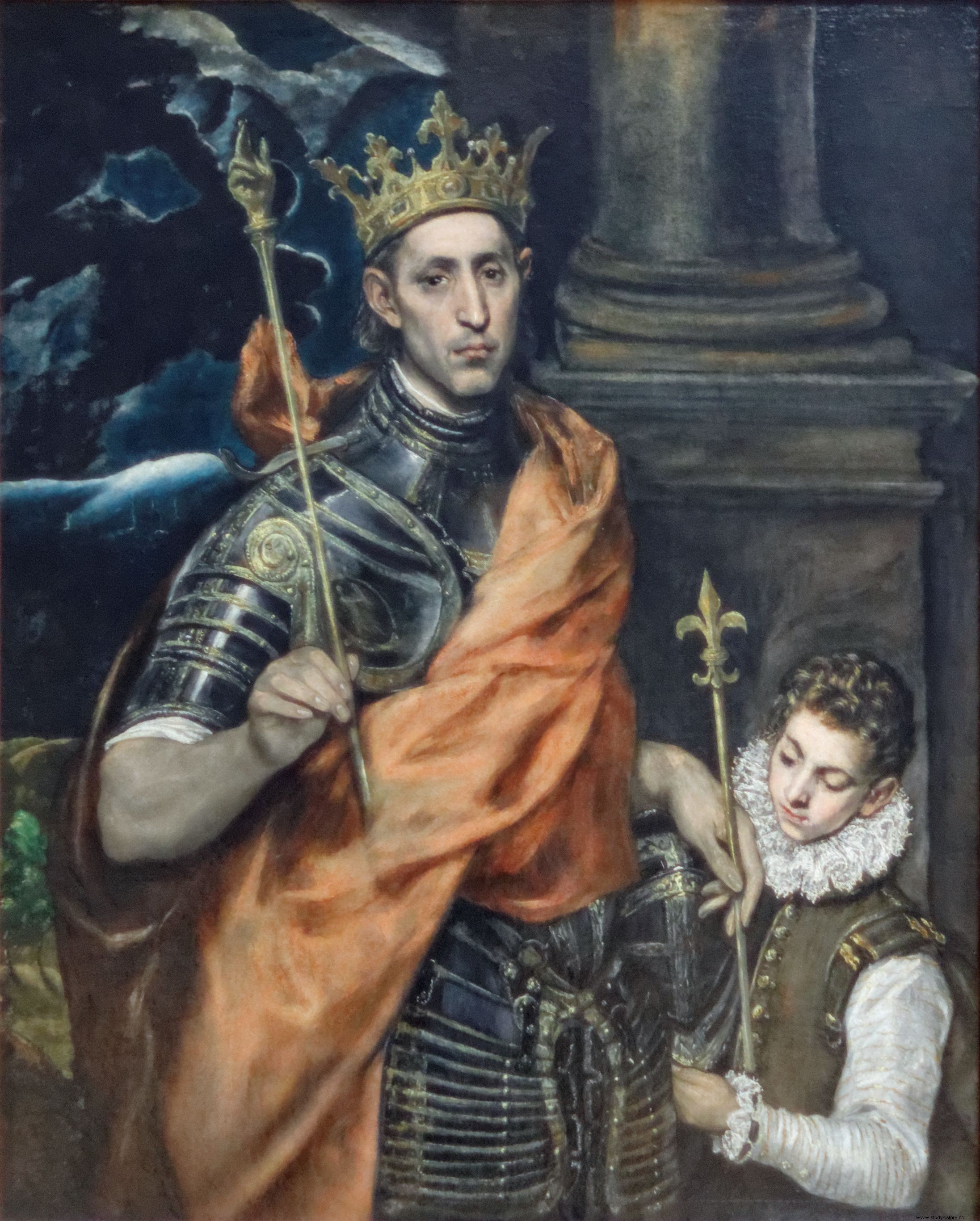
Louis IX's goal in life was to regain Jerusalem.
In 1250, the crusader army was in Egypt. Robert of Artois, at the head of some of his troops, crossed the Nile. Only that, against the orders of the king's brother, he did not wait and decided to conquer the nearby city, Al-Mansura. Accompanying him, the Grand Master of the Templars, William of Sonnac, reminded him of the king's command, but the proud count ignored his words.
The attack on Al-Mansura turned out to be a disaster. Many Christian knights died, including Robert of Artois himself. Out of 290 Templars, only 5 survived. Among the survivors was William of Sonnac, who lost an eye during the fighting - he was hit by the defenders of Al-Mansura with a flaming torch.
Soon the Muslims went on a counteroffensive. On February 11, 1250, they attacked the crusader camp. The Christians managed to defend themselves, but at the cost of considerable losses. The Templars on the front lines were particularly brave. Grand Master Wilhelm of Sonnac lost his second eye during the fights, and soon after that, his life. As a direct witness, John of Joinville, wrote, "the acre of land behind the Templars was so tightly obscured by the arrows fired by the Saracens that nothing was visible from under them."
He spoke but they did not listen to him (William of Beaujeu, 1291)
The Kingdom of Jerusalem disappeared from the political map in two stages. The beginning of its fall can be dated to 1187, when Jerusalem itself fell into the hands of Muslims. The second and final crisis occurred in 1291, when the followers of Allah seized Akka as the capital. The first of these disasters was due in part to listening to the Grand Templar Master Gerard of Ridefort. The second is that the Grand Templar Master, Wilhelm of Beaujeu, was not listened to.

He was an ambitious and energetic knight who realized the power of Mamluk Egypt could easily absorb the remnants of the Crusader states in the Middle East. In his opinion, first of all, it was necessary not to provoke the powerful neighbor. Meanwhile, in 1290, newcomers from Italy, wanting to fight Muslims, slaughtered the inhabitants of Akka who profess Islam . In addition, they also killed local Christians because they were convinced that only Muslims wear beards.
The Egyptian Sultan Kalavun demanded that the guilty be punished. William of Beaujeu, wanting to save the situation, suggested that the Christian criminals held in prisons in Akka be handed over to him as alleged perpetrators of the murder, but his advice was disregarded. Kalawun soon began his war preparations.
Officially, the Egyptian army was about to move on to its African neighbors, but the Grand Templar Master had a high-ranking informant, Emir Al-Fachri, from whom he learned that Akka was the real target. However, the highest lay dignitaries and clergy of the Kingdom of Jerusalem did not believe these reports.
With the Egyptian army close, Kalavun promised to spare Akka for the price of a Venetian sequin from every inhabitant. The Grand Master of the Templars advised to accept the offer, but he was challenged by traitors and cowards. His adversaries might have triumphed as death soon took Kalawun and the expedition was canceled.
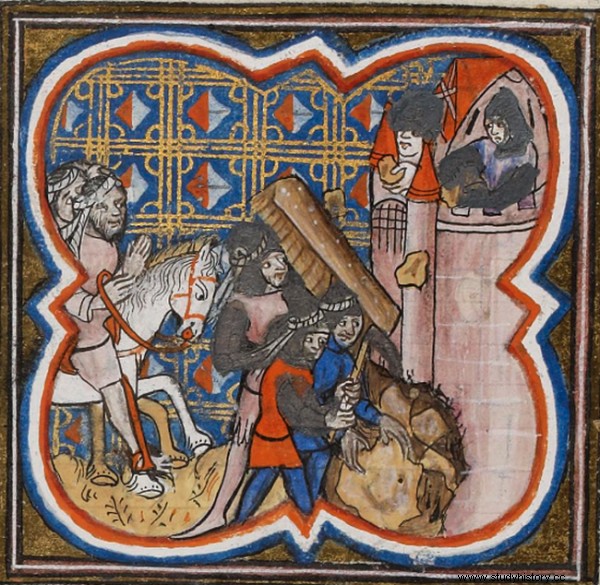
14th-century miniature of the siege of Akka.
A year later the smile slipped from their lips as Khalil, son and successor of Kalawun, brought an army and began the siege of Akka. On May 18, 1291, the Muslims launched a general assault. Their main attack was on the Cursed Tower. The attack was presented artistically by Paul Hill in the book:
The Tower of the Damned at the corner of the inner wall was pushed by attackers and its crew was pushed towards St. Anthony. In the roar and flames, fierce fighting broke out in the streets. William of Beaujeu, together with the Knights Templar and the Knights Hospitaller, set out to help the defenders of the Gate of St. Anthony, but the enemy was everywhere.
The Grand Master did not have time to properly fasten his armor ("Templar of Tire" noted that he was in a hurry to grab hold of his armor) and when he raised his left arm, an enemy hit him in the armpit spear. He had no shield, so the spear dug "a hand's length" into the flesh. It entered through the gap between the loose tiles. The master turned to some of the Italian crusaders and shouted: "Gentlemen, I can't do more. I'm dying. You see this wound! ” .
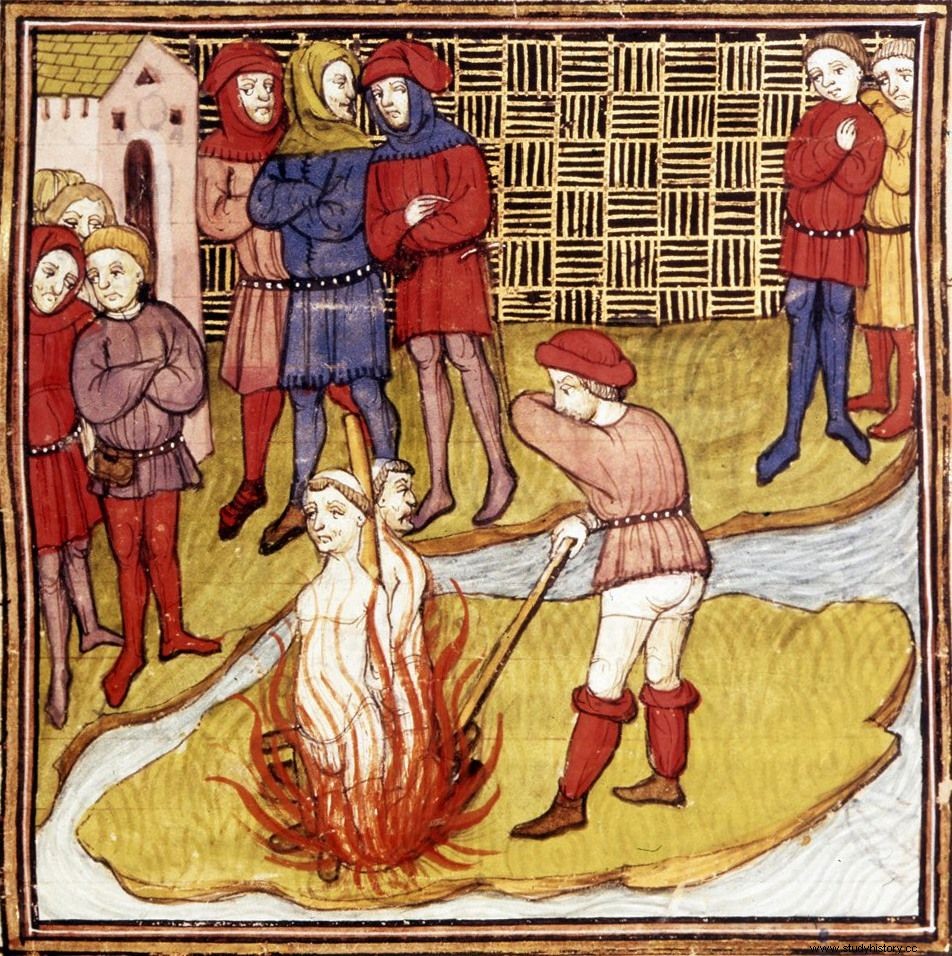
The last Grand Templar Master ended up at the stake.
William was transferred to a religious house, where he died soon. On the same day, the Muslims captured Akka, putting an end to the Kingdom of Jerusalem.
The Templars soon disappeared from the Holy Land. As a congregation, they survived for a little more than 20 years until they were dismantled by the French king Philip IV the Beautiful in collaboration with Pope Clement V. In 1314, on an islet on the Seine, the twenty-third Grand Master of the Knights Templar, Jacob of Molay, was burned at the stake. Thus, he closed the tragic history of his position - as many as 30% of those who held it died a sudden death ...
